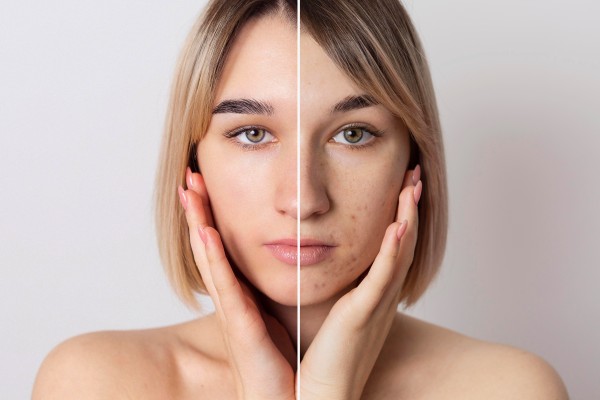
Melasma, a common skin condition, causes dark, discoloured patches to appear on the skin, particularly on the face. It’s not harmful but can affect one’s appearance and self-esteem. This blog will explore the factors causing melasma in Singapore and identify triggers that can exacerbate this condition. By understanding these elements, individuals can take steps to manage and possibly prevent melasma.
What is Melasma?
Melasma is a form of hyperpigmentation that typically appears as brown or grey-brown patches on the skin. These patches are usually found on the cheeks, bridge of the nose, forehead, chin, and above the upper lip. Although it can affect anyone, melasma is more common in women and people with darker skin tones.
Factors Causing Melasma
Several factors can contribute to the development of melasma. Understanding these can help in managing the condition effectively.
1. Hormonal Changes
Hormonal fluctuations are one of the primary causes of melasma. This is why the condition is often seen in pregnant women, which has led to the nickname “the mask of pregnancy.” Hormonal therapies and birth control pills can also trigger melasma due to the changes they cause in hormone levels.
2. Sun Exposure
Ultraviolet (UV) radiation from the sun stimulates melanocytes, the cells responsible for pigment production. When these cells become overactive, melasma can develop. Even a small amount of sun exposure can worsen melasma, making sun protection crucial for those prone to this condition.
3. Genetic Predisposition
Genetics also play a role in the likelihood of developing melasma. If a close family member has melasma, you may be more likely to experience it as well. This genetic predisposition can make the condition more challenging to manage.
4. Skin Care Products
Certain skin care products that irritate the skin can worsen melasma. Products containing harsh chemicals or fragrances can lead to inflammation, which can trigger melasma in susceptible individuals. It’s important to use gentle, non-irritating products to avoid exacerbating the condition.
5. Stress
Although not as commonly discussed, stress can contribute to the development of melasma. Stress affects hormone levels and can lead to various skin issues, including melasma. Managing stress through relaxation techniques and a healthy lifestyle can be beneficial.
Identifying Triggers
Undoubtedly, identifying and avoiding triggers is a crucial strategy in managing melasma. Consequently, here are some common triggers and, importantly, tips on how to avoid them:
1. Sun Exposure
Since sun exposure is a major trigger, it’s essential to protect your skin from UV rays. Use a broad-spectrum sunscreen with an SPF of 30 or higher every day, even on cloudy days. Wearing hats and seeking shade can also help minimize sun exposure.
2. Hormonal Changes
While it may not always be possible to avoid hormonal changes, such as those during pregnancy, discussing alternative contraceptive methods with a healthcare provider can help manage hormone-induced melasma. Hormone replacement therapies should also be carefully monitored.
3. Skin Irritants
Avoiding products that irritate the skin is crucial. Look for skin care products labelled “non-comedogenic,” “fragrance-free,” and “suitable for sensitive skin.” Patch testing new products before applying them to your face can help prevent irritation.
4. Heat
Heat can worsen melasma, so it’s advisable to stay cool and avoid prolonged exposure to high temperatures. Using fans, air conditioning, and cool compresses can help manage heat exposure.
5. Stress Management
Since stress can trigger melasma, finding ways to manage stress is important. Regular exercise, meditation, and sufficient sleep can help reduce stress levels. Engaging in hobbies and spending time with loved ones can also provide emotional support.
Melasma Treatment Options
For those seeking melasma treatment in Singapore, various options exist. Indeed, consulting a dermatologist is crucial to determining the most suitable treatment plan for your skin type and condition severity. Consequently, here are some typical treatment options:
1. Topical Treatments
Creams containing hydroquinone, tretinoin, corticosteroids, and other ingredients can lighten melasma patches. These treatments are often the first line of defence and can be effective when used consistently.
2. Chemical Peels
Chemical peels involve applying a solution to the skin that consequently causes it to exfoliate and peel off. As a result, this process can help reduce the appearance of melasma by effectively removing the outermost layer of skin while promoting new skin growth.
3. Laser and Light Therapies
Laser treatments can target and break up the pigment in melasma patches. However, these treatments should be approached with caution, as they can sometimes worsen the condition if not done correctly.
4. Microdermabrasion
This procedure involves exfoliating the skin with tiny crystals or a diamond-tipped wand. Specifically, microdermabrasion can help improve melasma by removing dead skin cells and thus promoting new skin growth.
5. Oral Medications
In some cases, oral medications such as tranexamic acid may be prescribed to help manage melasma. These medications work by reducing the activity of melanocytes and preventing the formation of new pigment.
Preventive Measures
Preventing melasma is often easier than treating it. Here are some preventive measures to consider:
1. Daily Sun Protection
Using sunscreen daily is one of the most effective ways to prevent melasma. Reapply sunscreen every two hours when outdoors and after swimming or sweating.
2. Gentle Skin Care Routine
Adopting a gentle skincare routine can help prevent irritation that may trigger melasma. Avoid scrubbing your skin too hard and use lukewarm water when washing your face.
3. Healthy Lifestyle
Ultimately, maintaining a healthy lifestyle through a balanced diet, regular exercise, and sufficient sleep can consequently help keep your skin in good condition while also reducing stress levels.
4. Regular Dermatologist Visits
Regular check-ups with a dermatologist can help monitor your skin’s condition and consequently adjust your treatment plan as needed. Furthermore, early intervention can prevent melasma from worsening.
Conclusion
Understanding the factors causing melasma and identifying its triggers is crucial in managing this common skin condition. Moreover, by taking preventive measures and seeking appropriate treatment, individuals can effectively reduce the appearance of melasma and improve their skin’s health. Consequently, if you’re dealing with melasma, consider consulting with a dermatologist for personalized advice and treatment options. Ultimately, while melasma can be a persistent condition, there are ways to manage it and maintain healthy, radiant skin.



